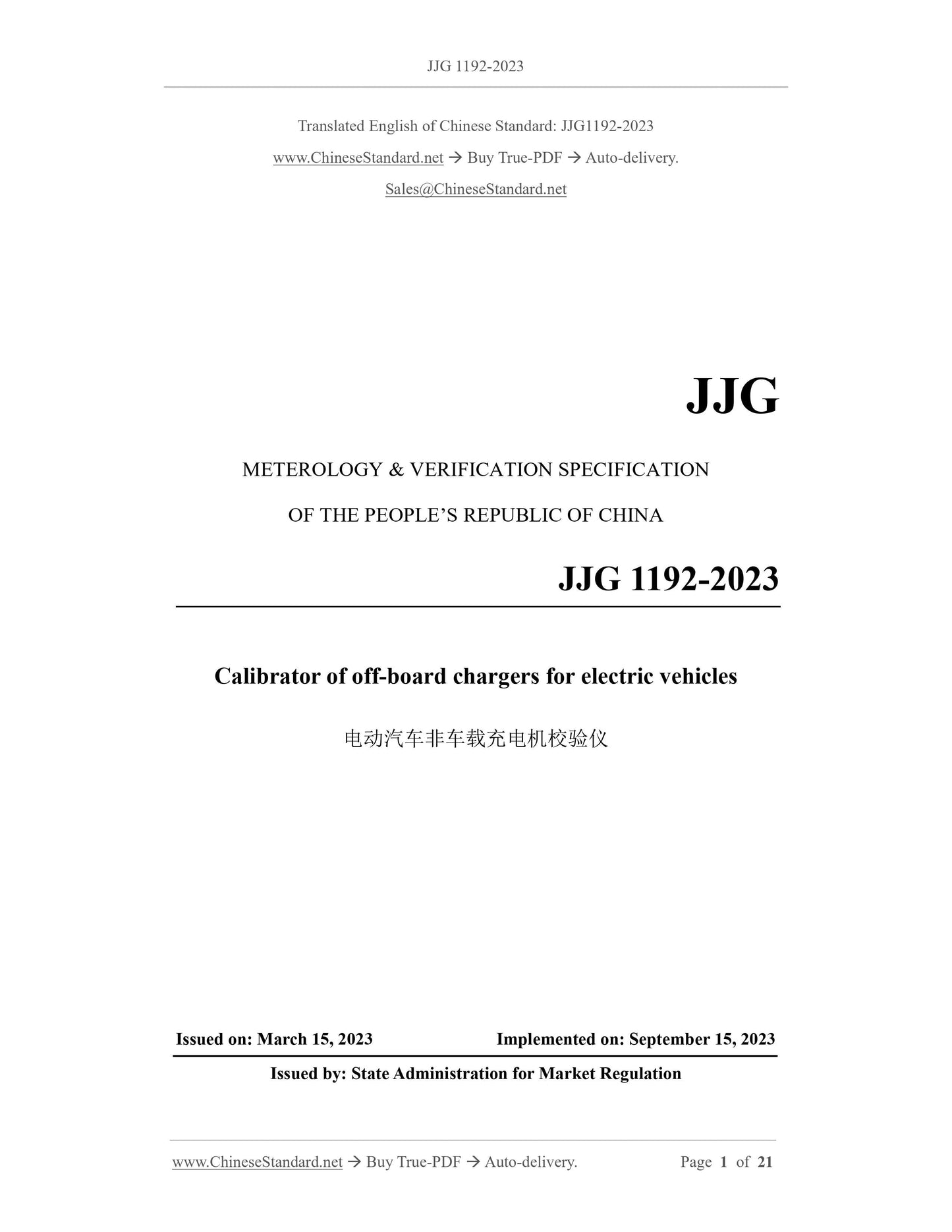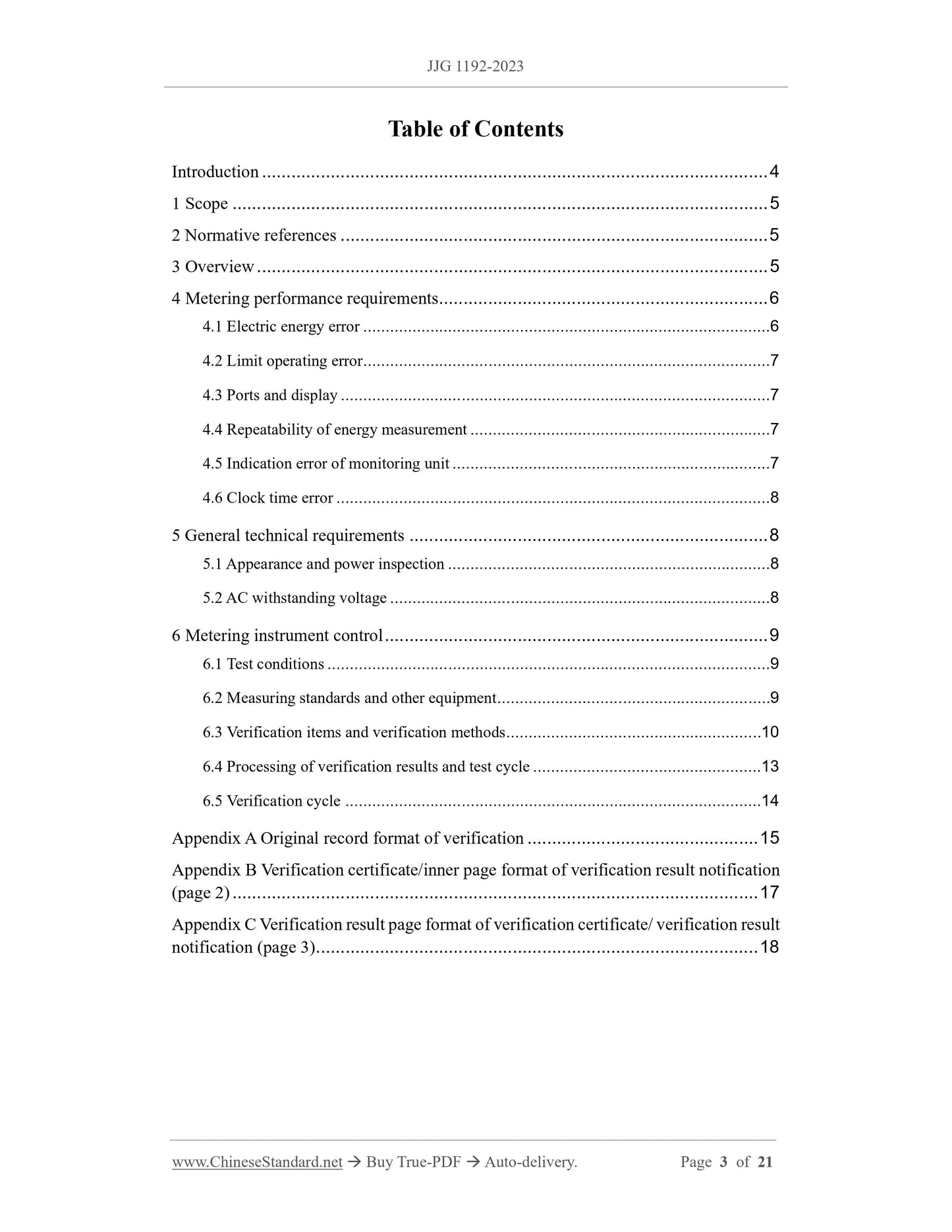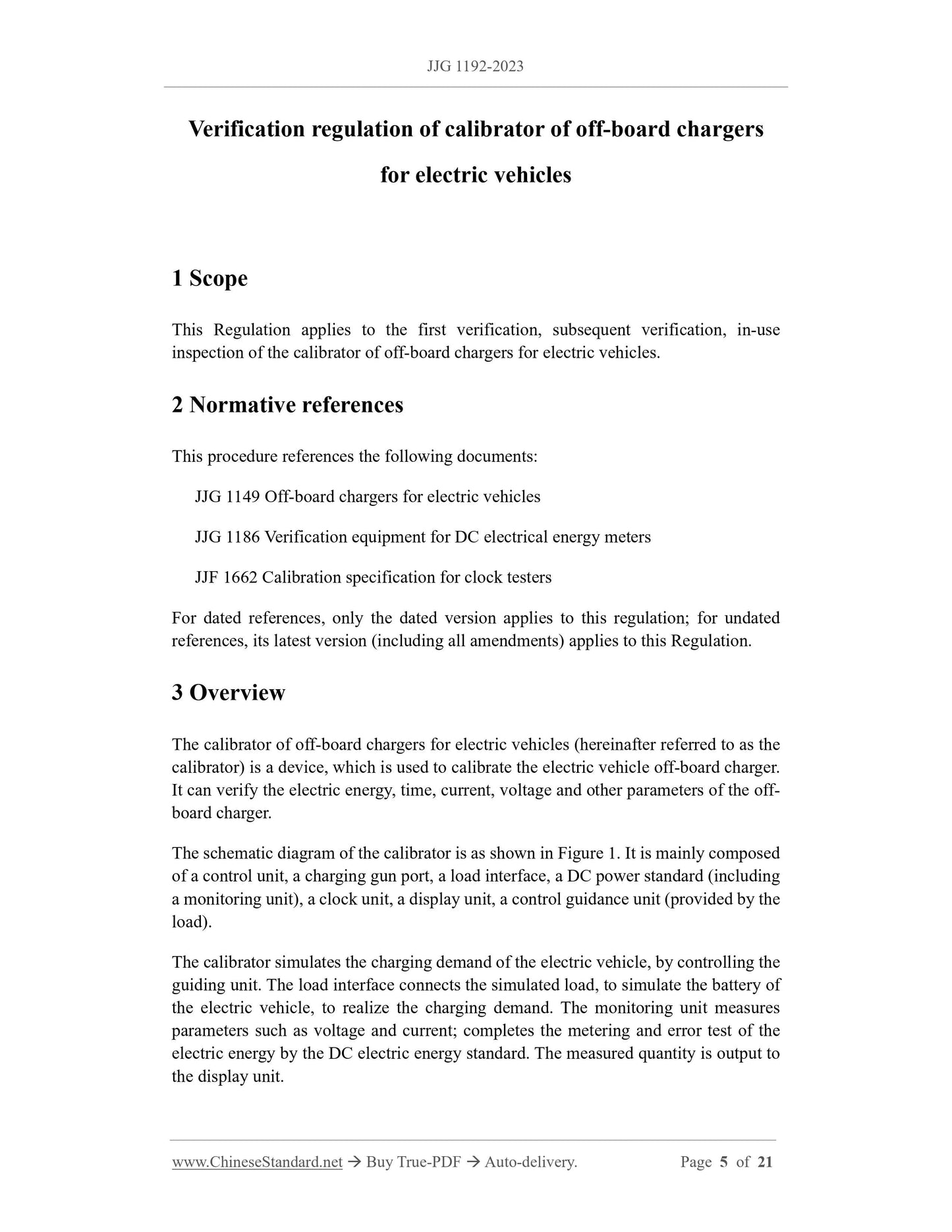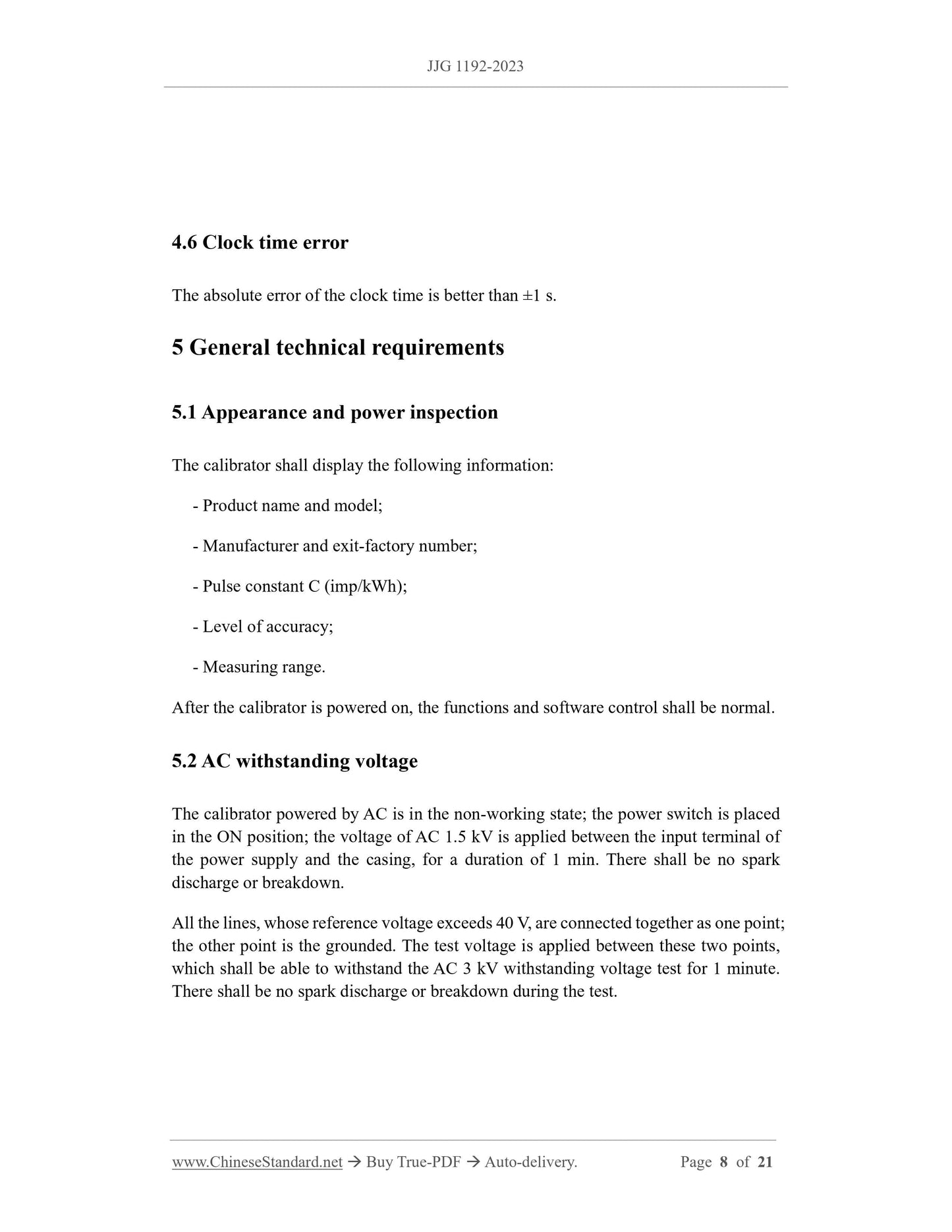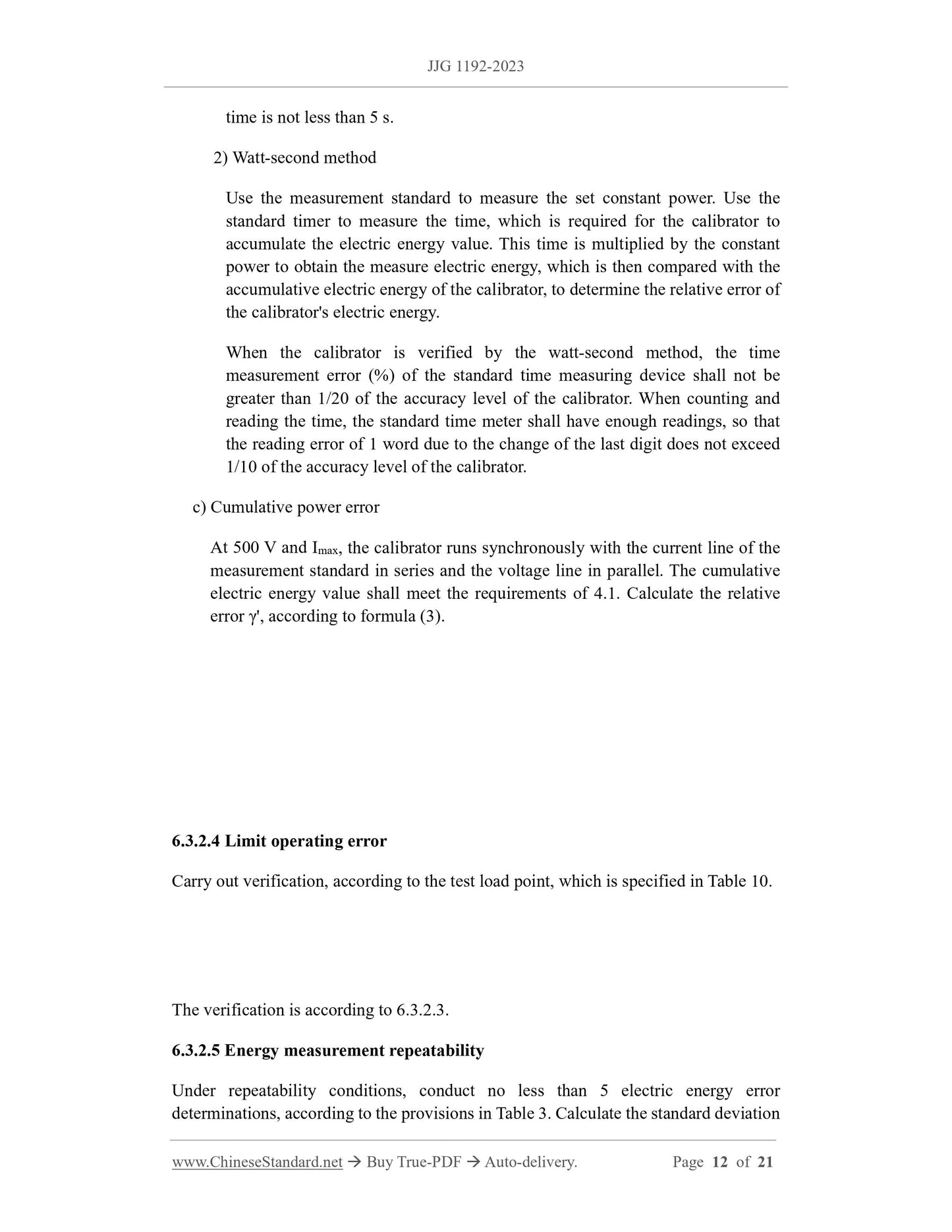1
/
of
5
PayPal, credit cards. Download editable-PDF and invoice in 1 second!
JJG 1192-2023 English PDF
JJG 1192-2023 English PDF
Regular price
$330.00 USD
Regular price
Sale price
$330.00 USD
Unit price
/
per
Shipping calculated at checkout.
Couldn't load pickup availability
Delivery: 3 seconds. Download true-PDF + Invoice.
Get QUOTATION in 1-minute: Click JJG 1192-2023
Historical versions: JJG 1192-2023
Preview True-PDF (Reload/Scroll if blank)
JJG 1192-2023: Calibrator of Off-board Chargers for Electric Vehicles
JJG 1192-2023
JJG
METEROLOGY and VERIFICATION SPECIFICATION
OF THE PEOPLE’S REPUBLIC OF CHINA
Calibrator of off-board chargers for electric vehicles
ISSUED ON: MARCH 15, 2023
IMPLEMENTED ON: SEPTEMBER 15, 2023
Issued by: State Administration for Market Regulation
Table of Contents
Introduction ... 4
1 Scope ... 5
2 Normative references ... 5
3 Overview ... 5
4 Metering performance requirements ... 6
4.1 Electric energy error ... 6
4.2 Limit operating error ... 7
4.3 Ports and display ... 7
4.4 Repeatability of energy measurement ... 7
4.5 Indication error of monitoring unit ... 7
4.6 Clock time error ... 8
5 General technical requirements ... 8
5.1 Appearance and power inspection ... 8
5.2 AC withstanding voltage ... 8
6 Metering instrument control ... 9
6.1 Test conditions ... 9
6.2 Measuring standards and other equipment ... 9
6.3 Verification items and verification methods ... 10
6.4 Processing of verification results and test cycle ... 13
6.5 Verification cycle ... 14
Appendix A Original record format of verification ... 15
Appendix B Verification certificate/inner page format of verification result notification
(page 2) ... 17
Appendix C Verification result page format of verification certificate/ verification result
notification (page 3) ... 18
Verification regulation of calibrator of off-board chargers
for electric vehicles
1 Scope
This Regulation applies to the first verification, subsequent verification, in-use
inspection of the calibrator of off-board chargers for electric vehicles.
2 Normative references
This procedure references the following documents:
JJG 1149 Off-board chargers for electric vehicles
JJG 1186 Verification equipment for DC electrical energy meters
JJF 1662 Calibration specification for clock testers
For dated references, only the dated version applies to this regulation; for undated
references, its latest version (including all amendments) applies to this Regulation.
3 Overview
The calibrator of off-board chargers for electric vehicles (hereinafter referred to as the
calibrator) is a device, which is used to calibrate the electric vehicle off-board charger.
It can verify the electric energy, time, current, voltage and other parameters of the off-
board charger.
The schematic diagram of the calibrator is as shown in Figure 1. It is mainly composed
of a control unit, a charging gun port, a load interface, a DC power standard (including
a monitoring unit), a clock unit, a display unit, a control guidance unit (provided by the
load).
The calibrator simulates the charging demand of the electric vehicle, by controlling the
guiding unit. The load interface connects the simulated load, to simulate the battery of
the electric vehicle, to realize the charging demand. The monitoring unit measures
parameters such as voltage and current; completes the metering and error test of the
electric energy by the DC electric energy standard. The measured quantity is output to
the display unit.
4.6 Clock time error
The absolute error of the clock time is better than ±1 s.
5 General technical requirements
5.1 Appearance and power inspection
The calibrator shall display the following information:
- Product name and model;
- Manufacturer and exit-factory number;
- Pulse constant C (imp/kWh);
- Level of accuracy;
- Measuring range.
After the calibrator is powered on, the functions and software control shall be normal.
5.2 AC withstanding voltage
The calibrator powered by AC is in the non-working state; the power switch is placed
in the ON position; the voltage of AC 1.5 kV is applied between the input terminal of
the power supply and the casing, for a duration of 1 min. There shall be no spark
discharge or breakdown.
All the lines, whose reference voltage exceeds 40 V, are connected together as one point;
the other point is the grounded. The test voltage is applied between these two points,
which shall be able to withstand the AC 3 kV withstanding voltage test for 1 minute.
There shall be no spark discharge or breakdown during the test.
time is not less than 5 s.
2) Watt-second method
Use the measurement standard to measure the set constant power. Use the
standard timer to measure the time, which is required for the calibrator to
accumulate the electric energy value. This time is multiplied by the constant
power to obtain the measure electric energy, which is then compared with the
accumulative electric energy of the calibrator, to determine the relative error of
the calibrator's electric energy.
When the calibrator is verified by the watt-second method, the time
measurement error (%) of the standard time measuring device shall not be
greater than 1/20 of the accuracy level of the calibrator. When counting and
reading the time, the standard time meter shall have enough readings, so that
the reading error of 1 word due to the change of the last digit does not exceed
1/10 of the accuracy level of the calibrator.
c) Cumulative power error
At 500 V and Imax, the calibrator runs synchronously with the current line of the
measurement standard in series and the voltage line in parallel. The cumulative
electric energy value shall meet the requirements of 4.1. Calculate the relative
error γ', according to formula (3).
6.3.2.4 Limit operating error
Carry out verification, according to the test load point, which is specified in Table 10.
The verification is according to 6.3.2.3.
6.3.2.5 Energy measurement repeatability
Under repeatability conditions, conduct no less than 5 electric energy error
determinations, according to the provisions in Table 3. Calculate the standard deviation
Get QUOTATION in 1-minute: Click JJG 1192-2023
Historical versions: JJG 1192-2023
Preview True-PDF (Reload/Scroll if blank)
JJG 1192-2023: Calibrator of Off-board Chargers for Electric Vehicles
JJG 1192-2023
JJG
METEROLOGY and VERIFICATION SPECIFICATION
OF THE PEOPLE’S REPUBLIC OF CHINA
Calibrator of off-board chargers for electric vehicles
ISSUED ON: MARCH 15, 2023
IMPLEMENTED ON: SEPTEMBER 15, 2023
Issued by: State Administration for Market Regulation
Table of Contents
Introduction ... 4
1 Scope ... 5
2 Normative references ... 5
3 Overview ... 5
4 Metering performance requirements ... 6
4.1 Electric energy error ... 6
4.2 Limit operating error ... 7
4.3 Ports and display ... 7
4.4 Repeatability of energy measurement ... 7
4.5 Indication error of monitoring unit ... 7
4.6 Clock time error ... 8
5 General technical requirements ... 8
5.1 Appearance and power inspection ... 8
5.2 AC withstanding voltage ... 8
6 Metering instrument control ... 9
6.1 Test conditions ... 9
6.2 Measuring standards and other equipment ... 9
6.3 Verification items and verification methods ... 10
6.4 Processing of verification results and test cycle ... 13
6.5 Verification cycle ... 14
Appendix A Original record format of verification ... 15
Appendix B Verification certificate/inner page format of verification result notification
(page 2) ... 17
Appendix C Verification result page format of verification certificate/ verification result
notification (page 3) ... 18
Verification regulation of calibrator of off-board chargers
for electric vehicles
1 Scope
This Regulation applies to the first verification, subsequent verification, in-use
inspection of the calibrator of off-board chargers for electric vehicles.
2 Normative references
This procedure references the following documents:
JJG 1149 Off-board chargers for electric vehicles
JJG 1186 Verification equipment for DC electrical energy meters
JJF 1662 Calibration specification for clock testers
For dated references, only the dated version applies to this regulation; for undated
references, its latest version (including all amendments) applies to this Regulation.
3 Overview
The calibrator of off-board chargers for electric vehicles (hereinafter referred to as the
calibrator) is a device, which is used to calibrate the electric vehicle off-board charger.
It can verify the electric energy, time, current, voltage and other parameters of the off-
board charger.
The schematic diagram of the calibrator is as shown in Figure 1. It is mainly composed
of a control unit, a charging gun port, a load interface, a DC power standard (including
a monitoring unit), a clock unit, a display unit, a control guidance unit (provided by the
load).
The calibrator simulates the charging demand of the electric vehicle, by controlling the
guiding unit. The load interface connects the simulated load, to simulate the battery of
the electric vehicle, to realize the charging demand. The monitoring unit measures
parameters such as voltage and current; completes the metering and error test of the
electric energy by the DC electric energy standard. The measured quantity is output to
the display unit.
4.6 Clock time error
The absolute error of the clock time is better than ±1 s.
5 General technical requirements
5.1 Appearance and power inspection
The calibrator shall display the following information:
- Product name and model;
- Manufacturer and exit-factory number;
- Pulse constant C (imp/kWh);
- Level of accuracy;
- Measuring range.
After the calibrator is powered on, the functions and software control shall be normal.
5.2 AC withstanding voltage
The calibrator powered by AC is in the non-working state; the power switch is placed
in the ON position; the voltage of AC 1.5 kV is applied between the input terminal of
the power supply and the casing, for a duration of 1 min. There shall be no spark
discharge or breakdown.
All the lines, whose reference voltage exceeds 40 V, are connected together as one point;
the other point is the grounded. The test voltage is applied between these two points,
which shall be able to withstand the AC 3 kV withstanding voltage test for 1 minute.
There shall be no spark discharge or breakdown during the test.
time is not less than 5 s.
2) Watt-second method
Use the measurement standard to measure the set constant power. Use the
standard timer to measure the time, which is required for the calibrator to
accumulate the electric energy value. This time is multiplied by the constant
power to obtain the measure electric energy, which is then compared with the
accumulative electric energy of the calibrator, to determine the relative error of
the calibrator's electric energy.
When the calibrator is verified by the watt-second method, the time
measurement error (%) of the standard time measuring device shall not be
greater than 1/20 of the accuracy level of the calibrator. When counting and
reading the time, the standard time meter shall have enough readings, so that
the reading error of 1 word due to the change of the last digit does not exceed
1/10 of the accuracy level of the calibrator.
c) Cumulative power error
At 500 V and Imax, the calibrator runs synchronously with the current line of the
measurement standard in series and the voltage line in parallel. The cumulative
electric energy value shall meet the requirements of 4.1. Calculate the relative
error γ', according to formula (3).
6.3.2.4 Limit operating error
Carry out verification, according to the test load point, which is specified in Table 10.
The verification is according to 6.3.2.3.
6.3.2.5 Energy measurement repeatability
Under repeatability conditions, conduct no less than 5 electric energy error
determinations, according to the provisions in Table 3. Calculate the standard deviation
Share
